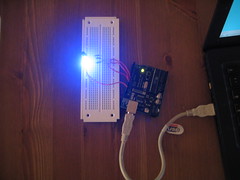I’ve had a few parts setting around a while for an upcoming electronics project, but it hasn’t gotten far off the ground because I was too lazy to spec out the control circuitry. I wanted it to be microcontroller based, but realizing that serial and parallel ports are ever-dwindling, I also wanted to make sure that I purchased/built a programmer that would still work in a few years’ time. Enter the Arduino, a perfect little development board based around the Atmel ATmega8; at only $30 for the board and chip, it’s a great deal. The chip comes pre-programmed with a bootloader that you can use over USB to upload your programs.
Programming the microcontroller is a snap. The Linux toolchain features a port of gcc and a small libc. There’s also watered down dialect of C and an IDE that noobs can use, but I just skipped to building with the arduino libraries and avr-gcc directly. Within 15 minutes of installing the necessary packages, I had my first program uploaded and blinking an LED. Pictured above is the second try, a simple RGB pixel consisting of 3 LEDs which fade among themselves (the effect is less than perfect without a good diffuser and smaller LEDs).
Here’s the code for the fade:
#include <WProgram.h>
int rpin = 9;
int gpin = 10;
int bpin = 11;
static int cols[3], i;
void setup()
{
pinMode(rpin, OUTPUT);
pinMode(gpin, OUTPUT);
pinMode(bpin, OUTPUT);
cols[0] = 255;
cols[1] = 0;
cols[2] = 0;
}
void next_color()
{
int before = i-1;
if (before < 0)
before = 2;
if (cols[i] < 255)
cols[i]++;
else if (cols[before] > 0)
cols[before]--;
else
i = (i+1) % 3;
}
void loop()
{
next_color();
analogWrite(rpin, cols[0]);
analogWrite(gpin, cols[1]);
analogWrite(bpin, cols[2]);
delay(10);
}

